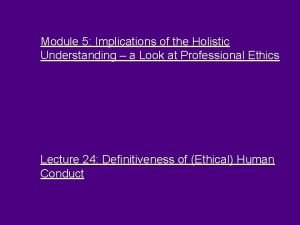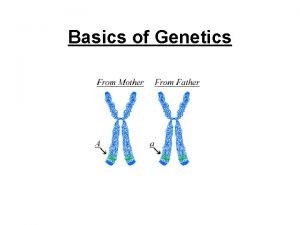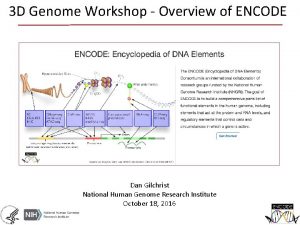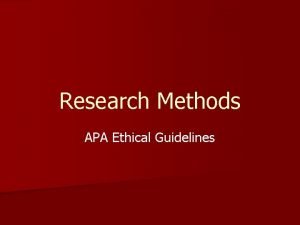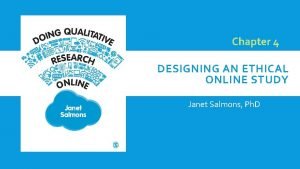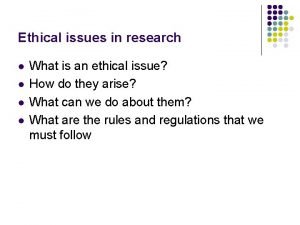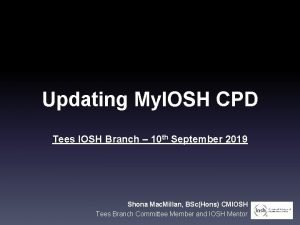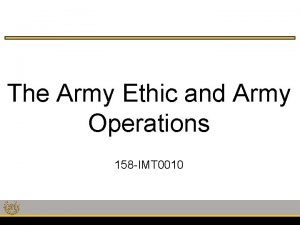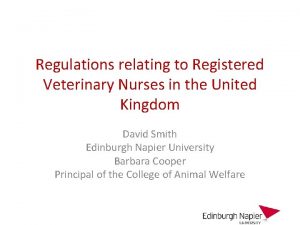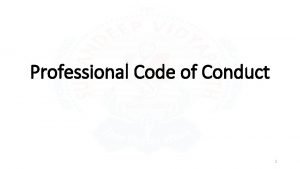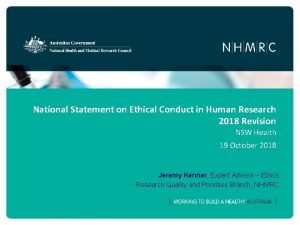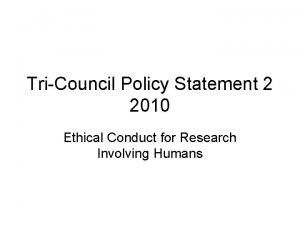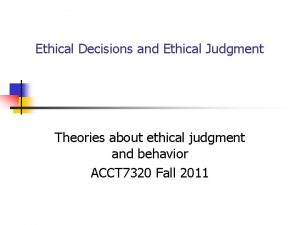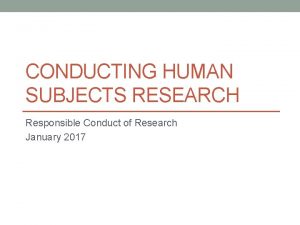National Statement on Ethical Conduct in Human Research









































- Slides: 41

National Statement on Ethical Conduct in Human Research 2018 Revision NSW Health 19 October 2018 Jeremy Kenner, Expert Advisor – Ethics Research Quality and Priorities Branch, NHMRC

The National Statement § Principles-based; mixture of high level guidance, prescriptive guidance and best practice § Four key principles, main issues (e. g. consent, risk), research ‘category’ and population-based considerations, establishment and operation of HRECs, institutional responsibilities § Applies to all human research, but only human research § Has undergone full review (2004 -06) and is now subject to ongoing review based on defined priorities

National Statement (Updated 2018) § National Statement (updated 2018) including fully revised Section 3: Ethical considerations in the design, development, review and conduct of research was released on 9 July 2018 § Major changes in structure and content – 3. 1. The elements of research: new structure, new content – 3. 2. Human biospecimens in laboratory based research: new structure, unchanged content (reviewed in 2013), – 3. 3. Genomic research: new structure, new content – 3. 4. Animal-to-human xenotransplantation: new chapter

Chapter 3. 1 The elements of research § Relates to research in general § Provides guidance related to specific types of research (e. g. clinical interventional research) as necessary § Incorporates guidance previously provided in Chapters 3. 1, 3. 2 and 3. 3 § Significantly increases guidance on ethical considerations related to collection, use and management of data and information in research

Chapter 3. 1 The elements of research Guidance provided through the elements of research § Element 1 – Research Scope, Aims, Themes, Questions and Methods § Element 2 – Recruitment § Element 3 – Consent § Element 4 – Collection, Use and Management of Data and Information § Element 5 – Communication of Research Findings or Results to Participants § Element 6 – Dissemination of Research Outputs and Outcomes § Element 7 – After the Project

Chapter 3. 3 § Addresses genomic research (vs ‘human genetics’) § Significantly increases guidance on ethical considerations related to management and potential return of results and findings with hereditary implications or implications for health § Includes decision tree graphic and detailed Ethically Defensible Plan

Chapter 3. 2 and Chapter 3. 4 § Chapter 3. 2: Human biospecimens in laboratory based research is unchanged in content (reviewed in 2013) § New Chapter 3. 4: Animal-to-human xenotransplantation

Section 5, Glossary and Index § Changes were made to Section 5: Processes of Research Governance and Ethical Review (in Chapters 5. 1, 5. 2 and 5. 5), the Glossary and the Index that flowed from the Section 3 revisions § These changes included: – Relocated content from (former) Chapter 3. 3 – Modified content related to safety reporting – Updated references

CONTENT of 2007 version Introduction to Section 3: Ethical considerations specific to research methods or fields NEW 2018 CONTENT COMMENT Introduction to Section 3: Ethical considerations in the design, Revised to introduce and explain the new development, review and themes and structure for the section conduct of research Chapter 3. 1: Qualitative methods Chapter 3. 2: Databanks Chapter 3. 1: The elements of research Chapter 3. 3: Interventions, etc. Chapter 3. 4: Human Biospecimens No Change Chapter 3. 5: Human genetics --- Chapter 3. 3: Genomic Research Chapter 3. 4: Animal-to-human xenotransplantation Chapter 5. 1: Institutional responsibilities Minor additions and modifications Chapter 5. 2: Responsibilities of HRECs … and researchers Minor additions and modifications Chapter 5. 5: Monitoring approved Significant modifications research Glossary and Index Chapters 3. 1, 3. 2 and 3. 3 combined into a single chapter with additional material Relocation of some material from Chapter 3. 3 into Section 5. Chapter not included in review as revised in 2013 Existing content organised to follow new structure Fully revised and updated chapter New chapter Changes were introduced to (a) accommodate material from Chapter 3. 3 (b) reflect current standards regarding safety monitoring (c) adjust numbering and cross-references. New glossary terms and updated Updated glossary and index reflect the new index content of Section 3


NS Review Working Group (2014 -ongoing) Chapter 3. 1 Working Committee (2015 -16) Chapter 3. 5 Working Committee (2015 -16) NS Section 3 Review Working Committee (201718) *Prof Wendy Rogers (Macquarie University) [Chair] *Dr Gary Allen (Griffith University) [Chair] *Prof Margaret Otlowski (University of Tasmania) [Chair] †A/Prof Clara Gaff (Walter and Eliza Hall Institute) [Chair] *Dr Gary Allen (Griffith University) *Prof Colin Thomson (Wollongong University) [Deputy Chair] Prof John Christodoulou (Murdoch Childrens Research Institute) *Dr Gary Allen (Griffith University) [Deputy Chair] *Prof Vicki Anderson (Royal Children’s Hospital) 2014 -16 *Prof Vicki Anderson (Royal Children’s Hospital) *Prof Susan Dodds (University of New South Wales) Prof Lisa Askie (NHMRC Clinical Trials Centre) *Prof Samar Aoun (Curtin University) Prof Sharon Roach Anleu (Flinders University) †A/Prof Clara Gaff (Walter and Eliza Hall Institute) Prof John Christodoulou (Murdoch Childrens Research Institute) †Prof Louisa Jorm (University of New South Wales) 2017 -ongoing Prof Lisa Askie (NHMRC Clinical Trials Centre) †Prof Ingrid Winship (Royal Melbourne Hospital) *Prof Susan Dodds (University of New South Wales) Prof Marian Simms (Australian Research Council) 2014 -16 Prof Daryl Higgins (Australian Catholic University) Observers: Prof Mark Israel (University of Western Australia) Mr Justin Withers (Australian Research Council) Prof Deborah Schofield (NHMRC Clinical Trials Centre) *Prof Margaret Otlowski (University of Tasmania) Dr Liz Eedle (Universities Australia) 2017 ongoing Dr Steven Webb (University of Western Australia / Monash University) *Prof Wendy Rogers (Macquarie University) Ms Sarah Brown (Universities Australia) 2014 -16 A/Prof Lisa Wynn (Macquarie University) Dr Steven Webb (University of Western Australia / Monash University) †Prof Ingrid Winship (Royal Melbourne Hospital) A/Prof Lisa Wynn (Macquarie University) Observers: Mr Justin Withers (Australian Research Council) Dr Liz Eedle (Universities Australia)

Implementation § Current National Statement (2007, updated 2015) remains in effect during a transition period (July 2018 -December 2018) § Users of the National Statement are expected to gradually integrate the new and revised guidance into their proposals, submissions and review during the transition period § New National Statement (updated 2018) will take full effect on 1 January 2019

National Statement Section 3 Ethical considerations in the design, development, review and conduct of research Introduction The aim of this section is to provide guidance on the ethical considerations that are relevant to the way that research is designed, reviewed and conducted. This material should be read in conjunction with the Preamble (Purpose, scope and limits, p. 6) and Section 2 (Themes in research ethics: risk and benefit, consent, pp 12 -21). This section aims to be compatible with and relevant for many different ways of doing human research. It requires those who conduct and approve human research to consider: § § § how the research question/theme is identified or developed the alignment between the research aims and methods how the researchers and the participants will engage with one another how the research data or information are to be collected, stored, and used how the results or outcomes will be communicated, and what will happen to the data and information after the project is completed.

The guidance in this section identifies common ethical issues that arise in the various phases of research. It is up to each researcher and HREC to apply the guidance to each project, taking account of the four principles of research merit and integrity, justice, beneficence and respect. This guidance facilitates consideration of the risks and benefits of the research and the level of ethical oversight required. The guidance in Chapter 3. 1 is broadly applicable to all fields of research, including those types of research for which additional specific guidance is provided in Chapters 3. 2, 3. 3 and 3. 4. [Elements] Researchers who are designing a research project should read all of Chapter 3. 1, noting which parts of the guidance are relevant for their project. In addition, if research involves biospecimens, genomics or xenotransplantation, they should also consult the specific chapters on these topics. [Innovative clinical practice] [Aboriginal and Torres Strait Islander Research – reference to NHMRC and AIATSIS guidelines]

CHAPTER 3. 1: THE ELEMENTS OF RESEARCH Introduction Human research projects must adhere to the core ethical principles described in Section 1 of this National Statement. These principles apply at all stages of a research project from inception to post-completion. Human research can involve a wide range of methods and practices: it can be qualitative, quantitative or mixed; interventional, experimental or observational in nature; and involve various degrees of collaboration between researchers and participants. Each research project is shaped by the field to which the research question relates, the research question itself, the desired outcome, and the context in which it is conducted. [Researcher – participant relationship / participant distress] Chapter 3. 1 should be read in conjunction with other sections of the National Statement and is supplemented by the guidance in Chapters 3. 2, 3. 3 and 3. 4. Researchers conducting clinical interventional research should also refer to additional guidance in Chapters 5. 2 and 5. 5.

Element 1: Research Scope, Aims, Themes, Questions and Methods 3. 1. 1 In an application for review of their research, researchers should determine and state in plain language: a) b) c) d) e) f) g) the research question or questions that the project is intended to explore; the potential benefit of exploring the question or questions including: i. ii. to whom that potential benefit is likely to flow, and whether that benefit is a contribution to knowledge or understanding, improved social or individual wellbeing, or the skill and expertise of researchers; the basis for that potential benefit as described in either relevant literature or a review of prior research unless, due to the novelty of the question, there is scarce literature or prior research; how the design and methods of the project will enable adequate exploration of the research questions and achieve the aims of the research; how the design of the project will maintain respect for the participants; where relevant, that the research meets the requirements of any relevant regulations or guidelines authorised by law (such as those related to privacy and reporting requirements for disclosure of child abuse); and whether or not the project has been reviewed by a formally constituted academic, scientific or professional review process, and, if so, the outcome of that review. 3. 1. 2 The merit and integrity of research should be assessed by criteria and standards relevant to the research field/s and methodology/ies, such as: a) b) c) the objectives and conceptual basis of the research; the quality and credibility of data collection and analysis; and how to assure validity and reliability of results, taking account of relevant statistical, thematic and other forms of generalisability.

3. 1. 4 For interventional research conducted in the context of health care or public health, researchers should additionally determine and state: a) b) c) d) whether the project involves the systematic investigation of the safety, efficacy and/or effectiveness of an intervention; if the research involves exposure to an intervention for which the safety or efficacy, or both, is not well understood: i. whether it is likely or possible that the intervention will be of therapeutic benefit and ii. whethere is a realistic possibility that the intervention being studied will be at least as beneficial overall as standard treatment, taking into account effectiveness, burden, costs and risks; where patient care is combined with intent to contribute to knowledge, that any risks of participation should be justified by potential benefits to which the participants attach significance. The prospect of benefit from research participation should not be exaggerated, either to justify to the reviewing body a higher risk than that involved in the participant’s current treatment or to persuade a participant to accept that higher risk; whether the intervention or other research procedures are without likely benefit to participants. For such research to be ethically acceptable, any known or emerging risks to the participants must not be greater than the risks that would be associated with the health condition and its usual care.

3. 1. 5 Where current and available treatments are known or widely believed to be effective and/or there is known risk of significant harm in the absence of treatment, placebo or non-treatment groups are not ethically acceptable. Non-treatment (including placebo alone) groups may only be used: a) where the existing standard of care comprises or includes the absence of treatment (of the type being evaluated); or b) where there is evidence that the harms and/or burdens of an existing standard treatment exceed the benefits of the treatment. 3. 1. 6 In health research involving an intervention, the risks of an intervention should be evaluated by researchers and reviewers in the context of the risks of the health condition and the treatment or treatment options that would otherwise be provided as part of usual care.

Element 4: Collection, Use and Management of Data and Information Collection, use and management of data and information must be in accordance with the ethical principles discussed in Section 1 of this National Statement. Research may involve access to large volumes of data or information not explicitly generated for research purposes. The size and accessibility of such sources make them attractive for some research designs, the use of which may raise difficult privacy and consent questions. However, because research using population-wide datasets is inclusive of all members of the population in question, it promotes the core principle of justice. In addition, benefits and burdens may be spread more evenly than research based on selected participants.

What is data and what is information? The terms ‘data’ and ‘information’ are often used interchangeably. Data can refer to raw data, cleaned data, transformed data, summary data and metadata (data about data). It can also refer to research outputs and outcomes. Likewise, information takes many different forms. Where information is in a form that can identify individuals, protecting their privacy becomes a consideration. For the purposes of the National Statement, ‘data’ is intended to refer to bits of information in their raw form, whereas ‘information’ generally refers to data that have been interpreted, analysed or contextualised. Data and information may include, but not be limited to:

Identifiability of information* Researchers and reviewers must consider the identifiability of data and information in order to assess the risk of harm or discomfort to research participants or others who may be at risk. … The identifiability of information is a characteristic that exists on a continuum. This continuum is affected by contextual factors, such as who has access to the information and other potentially related information, and by technical factors that have the potential to convert information that has been collected, used or stored in a form that is intended to protect the anonymity of individuals into information that can identify individuals. … Furthermore, the identifiability of information may change during the life of a research project … … Therefore, it is important for researchers and reviewers to focus on the risk of harm to affected individuals if their identity is ascertained and the effort that would be required to achieve this at each stage of a research project. [*The National Statement does not use the terms ‘identifiable’, ‘potentially identifiable’, ‘re-identifiable’, ‘nonidentifiable’ or ‘de-identified’ as descriptive categories for data or information due to ambiguities in their meanings. Re-identification and de-identification are best understood as processes that change the character of information and are only used with this meaning. ]

3. 1. 45 For all research, researchers should develop a data management plan that addresses their intentions related to generation, collection, access, use, analysis, disclosure, storage, retention, disposal, sharing and re-use of data and information, the risks associated with these activities and any strategies for minimising those risks. The plan should be developed as early as possible in the research process and should include … 3. 1. 50 In the absence of justifiable ethical reasons (such as respect for cultural ownership or unmanageable risks to the privacy of research participants) and to promote access to the benefits of research, researchers should collect and store data or information generated by research projects in such a way that they can be used in future research projects. Where a researcher believes there are valid reasons for not making data or information accessible, this must be justified.

Secondary use of data or information It is usually impractical to obtain consent from individuals for secondary use of this data or information. In these circumstances, respect for participants can be demonstrated in other ways, including, but not limited to, community consultation, ensuring that the research results are translated into improvements in services and practices, acknowledging the source of the data or information in publications and/or publishing the research results in a location and language suitable for the general community. … Data or information available on the internet can range from information that is fully in the public domain (such as books, newspapers and journal articles), to information that is public, but where individuals who have made it public may consider it to be private, to information that is fully private in character. The guiding principle for researchers is that, although data or information may be publicly available, this does not automatically mean that the individuals with whom this data or information is associated have necessarily granted permission for its use in research. Therefore, use of such information will need to be considered in the context of the need for consent or the waiver of the requirement for consent by a reviewing body and the risks associated with the use of this information.

3. 1. 52 Unless a waiver of the requirement for consent is obtained, any research access to or use of publicly available data or information must be in accordance with the consent obtained from the person to whom the data or information relates. 3. 1. 53 Researchers should understand the context in which data or information was collected or disclosed, including the existence of any relationship of confidence or, if available on the internet, the privacy settings that apply. This includes avoiding the use or disclosure of information that was obtained unethically or illegally. 3. 1. 54 Researchers should take account of any terms and conditions applicable to social media platforms when using data or information from these sources or platforms and other web-based communities that do not permit the removal of the name of the author of a post or any changes to the wording of a post.

Sharing of data of information 3. 1. 55 All data collections should have an identified custodian to enable access by researchers or participants to the data while maintaining it in a protected form. The custodian of the data may be the individual researcher or agency who collected the information, or an intermediary that manages data coming from a number of sources. 3. 1. 56 When planning to share data or information with other researchers or to establish or add them to a databank, researchers must develop data management plans in accordance with the guidance provided in 3. 1. 45. This plan should enable the sharing of data and information and propose appropriate conditions on the sharing of data and information. 3. 1. 57 Researchers must make data custodians aware of the data management plans for banking or sharing of the data or information …

3. 1. 59 In any proposals to share or disclose research data or information, researchers should distinguish between disclosure to specific third parties, sharing with other researchers and disclosure to the public and clarify whether the sharing of data or information is subject to participant consent, other voluntary agreements or mandatory requirements. 3. 1. 60 Researchers should be aware of expectations and policies regarding the sharing or re-use of participant data or information in any form and should consider the value of the data or information for future research. At the time of initial consent, participants should be informed of these expectations and given appropriate options, including the potential to provide extended or unspecified consent … 3. 1. 62 Shared or banked data or information that is stored in a form that can identify individuals can sometimes be used in research that qualifies as negligible or low risk research; however, it cannot be used in research that is exempt from ethics review (see paragraph 5. 1. 22).

Chapter 3. 3: Genomics Research • Scope and review • Guidance for genomic research vs clinical genomics • Rapid evolution of field/analytical techniques • Nature of ‘participation’ and implications • Consent • Return of results and findings

Scope This chapter is about generating, gathering, collecting, conveying or using genomic data or information that has hereditary implications and/or is predictive of future health in research involving participants, relatives and other family members. It applies irrespective of the nature of the source material for the research, such as data or biological materials such as germline/germ cells or somatic cells. This chapter is relevant to different types of genomic research (e. g. family studies, clinical research, population health research, health service research). Some research that falls within the broad description of genomic research does not involve information that is relevant to the future health of the individual participant and does not generate sensitivities for the individual, or his or her family or community. An example of this research is a population survey of preferences regarding disclosure of genomic information where identifiers related to survey results are not disclosed.

Review Genomic research is frequently considered to be greater than low risk, especially in the context of research involving Indigenous peoples. For this reason, relevant on-going community consultation and active agreement on the part of communities and traditional owners is an essential component of the planning and conduct of this research. … As a general principle, research including genomics will require review by an HREC; however, if no information that can identify an individual is used and no linkage of data is planned, the research may be determined to carry low risk.

Research vs clinical In genomic investigations, there may be a strong relationship between the research and clinical contexts such that there may be clinical implications of research results or findings. Nevertheless, differences between results that are associated with research and results that are associated with clinical investigations should be clear, especially when the researcher is also a clinician and where clinical care is ongoing. Where appropriate, researchers should refer to clinical practice guidelines…

Rapid Evolution Genomic research is characterised by the original intention of the investigation and the potential hereditary and/or future health implications, if any, of the information that is collected or generated by the investigations… 3. 3. 3 Methods used in genomic research are not a static set, but are constantly evolving and, as they are developed and applied, may require ethical consideration on an ongoing basis. Therefore, the ethical principles and guidance in this chapter should be considered with reference to the new technologies as they are developed and applied.

Nature of Participation 3. 3. 4 In addition to participants in genomic research identified as index cases (probands), relatives of these individuals who provide information or biospecimens for genomic research become participants in the research in their own right. Therefore, researchers should be aware of the possibility of the involvement of relatives by virtue of association with a participant or other family member who has been recruited. 3. 3. 16 Collection of information about family history for genomic research may involve the collection of information about family members who are not aware that information about them is being collected … Genomic information can be predictive, unchanging, sensitive and familial. Genomic information has the unique character of being both specific to an individual and specific to relatives of that individual and, in some cases, of significance to human population groups such as groups that define themselves via their ancestral lineages.

Consent 3. 3. 10 In considering the appropriate form and scope of consent and the most appropriate process for obtaining consent, researchers should consider: a) b) c) d) e) f) g) h) i) what information will be generated by the research; what may be discovered by the research; what will be deliberately excluded from the scope of the research; which, if any, of the findings of the research will be communicated to participants and, if so, how; what the health implications are of the information for participants and their relatives; whethere any other implications for participants and their families of being given this information (e. g. insurance, employment, social stigma); the potential for the information generated by or used in the research to result in participants being re-identified; whether information generated by the research will be shared with other research groups; and potential future use of information and biospecimens, including commercial applications. 3. 3. 11 Participants should be advised that information that they may be given about the likely impact of the genomic information may change over time as new knowledge/insight is gained and how to obtain updated information.

3. 3. 14 Consent specific to the research may not be required or a waiver of the requirement for consent may be considered by an HREC if: a) b) c) d) the data or information to be accessed or used was previously collected and either aggregated or had identifiers removed; or prior consent for the use of the data or information was provided under the scope of a research program that encompasses the proposed research project; or prior consent for the use of the data or information was provided in the clinical context for research that encompasses the proposed research project; or unspecified consent has been provided. 3. 3. 17 Researchers should not presume that the decision to participate in genomic research includes a decision to receive the results of that research. Where researchers consider that the results must be provided to participants, the project should be designed to include the mandatory return of results and this condition should be clear in any information materials.

Return of results and findings 3. 3. 26 In considering whether to return results of research, researchers should distinguish between individual research results and overall research results. Researchers should consider how these results will be provided to participants, how the process of returning results will be managed and the risks of the return of individual research results and overall research results. 3. 3. 27 Return of findings and results relating to an individual participant depends on the contextual relevance of the findings; some genomic research findings must be returned, some findings may be returned and some findings should not be returned.

3. 3. 34 Over time there may be a substantive change in the understanding of the significance of the research results or findings. For the duration of the research project, researchers have a responsibility to provide the research cohort with the opportunity for each participant to reconsider their decision related to receiving results or findings (see 3. 3. 53 -3. 3. 55). 3. 3. 35 In all other cases, any obligation to further analyse or interpret genomic data related to participant information ceases at the end of the project

SECTION 3: ETHICAL CONSIDERATIONS IN THE DESIGN, DEVELOPMENT, REVIEW AND CONDUCT OF RESEARCH CHAPTER 3. 3 : GENOMIC RESEARCH Decision tree for the management of findings in genomic research and health care Relevant for clinical practice only Was the investigation requested by or on behalf of a primary treating clinician? (see Note 1) Yes Was the investigation a validated test performed in a NATA accredited lab or overseas equivalent? Action Question No Was the investigation performed as part of an approved research project? No No (see note 3) Yes Does the protocol permit the return of any findings from the research? Do not return findings Are the results pertinent to the indication for testing? No Yes No (see note 2) Does the protocol include criteria and a process for the return of findings, including secondary and/or incidental findings? (See Note 4) Did the patient consent to the return of findings, including secondary and/or incidental findings? Follow standard clinical practice Yes Follow policy and/or patient preferences No Consult current best practice or national clinical genomics guidelines Are the findings pertinent findings? Yes Did the participant consent to the return of pertinent findings? Yes (see note 6) Follow process as described in protocol Do not return findings No Consult HREC re: establishment of a process for review of findings, consultation with clinicians and criteria for contact with research participants No (see note 5) Do not return findings (unless national / international standard or protocol is for mandatory return of some or all incidental findings) No Do not return findings (unless protocol mandates return of pertinent findings) Note 1: Clinicians who do not request an investigation or on whose behalf an investigation was not requested or who subsequently refer a patient to a different primary treating clinician do not have an obligation with respect to management of the findings of the investigation. Note 2: The patient must be advised of the policy +/- options addressing the return of findings including incidental findings. Note 3: A “no” answer includes scenarios in which a non-validated test is performed in a NATA accredited lab or overseas equivalent AND in which a validated test is performed in a non-accredited lab. Situations in which this might occur include the development of diagnostic tests and research testing that has not been approved as part of a research project. In the first situation (test development), findings should not be returned. The second situation (unapproved testing) is contrary to ethical standards. Note 4: The criteria and process must specify: 1) that any findings must be verified by a NATA accredited lab; 2) which findings will be returned; 3) who will be consulted prior to the return of the findings; 4) who will return the findings; and 5) to whom the findings will be returned. Note 5: If the findings are not pertinent findings, then any return of findings will be based on the policy established by the research protocol and/or by international standards. Note 6: Refer to guidance in this chapter regarding requirements related to consent for the return of findings from genomic research. Key Terms Pertinent findings: Also known as primary findings, pertinent findings are those that were the primary objects of the investigation. Secondary findings: Findings that were not the primary target of the investigation, but were either specifically sought or are related to the primary target and anticipated as likely to arise. Incidental findings: Findings of potential clinical significance unexpectedly discovered during the investigation. NB: With respect to full spectrum ‘discovery’investigations and direct-to-consumer testing, one is explicitly searching for any and all findings and so no findings can be considered ‘unexpected’. 52 | NATIONAL STATEMENT ON ETHICAL CONDUCT IN HUMAN RESEARCH, 2007 (UPDATED 2018)

Guidance for the Development and Evaluation of an Ethically Defensible Plan for the Potential Return of Findings and Individual Results from Genomic Research • • The Nature of Research Findings Determination of Whether Findings Will Be Returned Validation and Assessment of Findings Consent to Disclosure of Findings and Notification Requirements • Communication process – Who, to Whom, How, When • Privacy Issues Specific to Genetic Information

3. 3. 53 Researchers should respect the decision of a participant not to receive information on the research findings, including information that is important for their health, and should not routinely seek to confirm the preference at a later point in time. 3. 3. 54 As the nature of information may change during a research project, researchers should be prepared to provide information to participants who, after indicating that they prefer not to receive information, later change their preference and request to receive the information (see 3. 3. 17 and 3. 3. 34). 3. 3. 55 Researchers should advise participants that, if they change their preference and wish to receive the information, they may contact the research team to request it and that the researchers will provide the information if it is practicable to do so.

Take Home Messages 1. The underlying ethical principles of the National Statement remain unchanged in this version 2. Specific, detailed guidance should be read and interpreted in the context of the broader ethical framework 3. Section 3 aims to address contemporary issues in research ethics and to anticipate future issues 4. The new structure of Section 3 is designed to assist researchers and HREC members to address ethical issues in research in a transparent and systematic way 5. As always, high quality ethical review relies on thoughtful consideration of the research, by all parties.

ethics@nhmrc. gov. au jeremy. kenner@nhmrc. gov. au 03 8866 0416
 Holistic understanding of harmony on professional ethics
Holistic understanding of harmony on professional ethics Perbedaan ethical dilemma dan ethical lapse
Perbedaan ethical dilemma dan ethical lapse Army ethical lenses
Army ethical lenses Csr and business ethics
Csr and business ethics Ethical decision making and ethical leadership
Ethical decision making and ethical leadership National human genome research institute
National human genome research institute National human genome research institute
National human genome research institute Codom
Codom Encode
Encode National statement human ethics
National statement human ethics Interview kvale og brinkmann
Interview kvale og brinkmann On being a scientist responsible conduct in research
On being a scientist responsible conduct in research Ethical considerations in experimental research
Ethical considerations in experimental research Ethical dilemma in research
Ethical dilemma in research Apa ethical guidelines animal research
Apa ethical guidelines animal research Ethical issues in qualitative research chapter 4
Ethical issues in qualitative research chapter 4 Ethical issues in research
Ethical issues in research What is research design in qualitative research
What is research design in qualitative research Ethical issues in research
Ethical issues in research Moral consideration in ethics
Moral consideration in ethics Ethical consideration sample paper
Ethical consideration sample paper Ethical consideration example in research
Ethical consideration example in research National unification and the national state
National unification and the national state Gross national product definition ap human geography
Gross national product definition ap human geography Iosh reflective account example
Iosh reflective account example What material does not conduct electricity
What material does not conduct electricity Code of conduct unhcr
Code of conduct unhcr Werner henke
Werner henke Tlo army
Tlo army Laws that regulate public conduct
Laws that regulate public conduct Anz credit risk
Anz credit risk Veterinary nurse conduct and discipline rules 2014
Veterinary nurse conduct and discipline rules 2014 Substance
Substance 8 general moral imperatives
8 general moral imperatives Bcs ethics
Bcs ethics Code of conduct professional ethics
Code of conduct professional ethics Security survey is coined from the word
Security survey is coined from the word Articles of the code of conduct
Articles of the code of conduct It is a gift bestowed to influence a recipient’s conduct.
It is a gift bestowed to influence a recipient’s conduct. Market conduct and performance
Market conduct and performance Market conduct supervision
Market conduct supervision Second grade homework
Second grade homework
